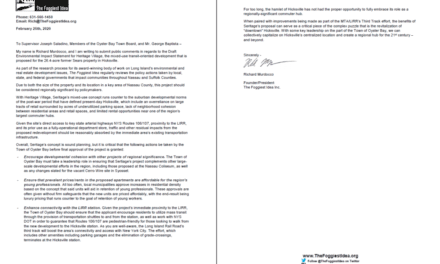The following was written for LIBN’s Young Island:
Recently in LIBN, former Suffolk County Executive Steve Levy wrote an interesting Op-Ed calling for the creation of Long Island’s very own metropolitan planning organization to act as a conduit for federal moneys needed to help us upgrade our aging roads and transit infrastructure.
The argument is that because of our affiliation with the New York Metropolitan Transit Council, we miss out on transportation projects that instead go to New York City. As Levy put it “given the fact that we are living within the shadow of New York City, almost all of the funds for major initiatives get gobbled up by projects there, leaving just crumbs for Long Island.” Levy went on to write: “It is time we get the respect we deserve when it comes to transportation funds.”
I feel Levy’s op-ed exposes just the tip of the iceberg. He’s right in saying that it’s time we get the respect we deserve, but the problem goes beyond Nassau and Suffolk getting New York City’s scraps and transit fund leftovers. Why are we second fiddle in the first place?
New York City and Long Island share a long and complicated relationship. The unwritten rule of the relationship is as follows: We stay out of the city’s way as it drives economic growth for us and the rest of the state, and in return, we get the privilege of being next to one of the premier global cities in the world. Since the completion of the Brooklyn Bridge in 1883, our fate has been directly tied to the city, and vice-versa. During the post-World War II suburban boom years, Long Island got fat on the wealth of the city, all while New York crumbled from within. The mass exodus from cities to the suburbs benefited Nassau and Suffolk immensely, but now it seems the gravy train has reached the end of the line. The recession hit everyone hard, but the housing crisis left older suburban areas scrambling for growth, residents and sales tax revenues.
What we’re left with is an interesting problem. Long Island’s relationship with New York City has evolved. Nassau and Suffolk are no longer suburbs per se, traditionally defined as the bedroom communities for a core city. Now, Long Island can primarily be classified as a “technoburb,” a term coined by Robert Fishman in 1987. A technoburb is “a peripheral zone that has emerged as a viable socioeconomic unit.” This evolution creates an interesting array of problems.
Now, instead of being a subservient suburb to our urban neighbor to the west, Long Island directly competes with New York City for businesses, multinational corporations, residents and the jobs and tax dollars they bring. With so many of our suburbs aging, Long Island is struggling to stay competitive. So far, our approach has been looking to attract the same tech industries and companies that New York City is looking to court. Our health services sector is in direct competition with the city, as are our colleges and universities competing for the same students and patients. If we’re looking to beat New York City at its own game, we won’t win.
To succeed, Long Island needs to be leaner than the city, quicker to adapt to new business trends, cheaper to do business in, and take advantage of the one asset we have that New York City doesn’t: space. We have vast amounts of acreage that is currently underutilized and zoned for commercial and industrial usage that the city just can’t compete with. Further, we have the workforce to drive growth in these areas. New York City may have always provided the jobs, but Long Island, as well as the other suburbs to the north and west, provided the work force.
To succeed regionally, we need to take stock of our regional assets and both capitalize on and maximize them. The current approach of taking on New York City head-on isn’t sound planning. Rather, we should look at New York City’s advantages and work to supplement and complement them. We need to capitalize on our remaining vacant acres to provide housing for all Long Islanders who will help us and maximize that acreage to complement the services New York City provides. Light manufacturing, green tech and other “clean” industrial-type businesses will take advantage of our educated workforce. It’s time to start investing in our future.
Then, and only then, will Long Island be able to silently compete with the city that never sleeps.
Richard Murdocco is a digital marketing analyst for Teachers Federal Credit Union, although the views expressed in this post are Murdocco’s alone and not shared by TFCU. Follow him on Twitter @TheFoggiestIdea, or email him at rich.murdocco@gmail.com.












I am really shocked by the info of this website and i am glad i experienced a seem over the weblog. thank you so a lot for sharing this sort of wonderful data.
rochester limousine
rochester ny limousine?services
Paul-
Thanks for taking the time to read my work. My goal is to use my policy background to make land use issues approachable to the public. I am glad to hear that you enjoyed my writing!